Figures & data
Figure 1. Hyperthermic sensitivity in undifferentiated and neurone-like SH-SY5Y cells. Cells were exposed to the indicated temperatures for 30 min. After 18 h recovery at 37°C, the percentage of cells undergoing cell death was determined. Where indicated, cells were thermally preconditioned (PC) by heating at 43°C for 30 min followed by recovery at 37°C for 8 h before subsequent severe hyperthermic stress at the temperatures shown. All results are from three independent experiments. Error bars indicate standard deviation.
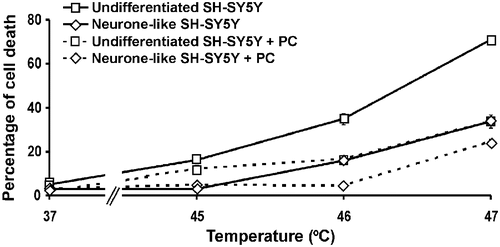
Figure 2. Hsp72 expression levels of SH-SY5Y and 5YHSP72.1 cells. (A) Undifferentiated and neurone-like SH-SY5Y cells were heated at 43°C for 30 min and allowed to recover for 8 h at 37°C before harvesting. Cell lysates were obtained from before and after differentiation with RA and BDNF, with or without mild hyperthermic stress at 43°C for 30 min (PC). Lysates were subjected to western immunoblotting with anti-Hsp72 and actin antibodies. In this case secondary antibodies conjugated to Alexa fluorochromes were used. (B) Levels of Hsp72 induction were quantified by densitometric analysis of images in . (C) Undifferentiated and neurone-like 5YHSP72.1 cells were heated at 43°C for 30 min and allowed to recover for 8 h at 37°C. Lysates were subjected to western immunoblotting as in . These were run on the same gel as in panel A, hence the continuity in lane numbering. (D) Levels of Hsp72 induction were quantified by densitometric analysis of images in . *Fold induction values from all densitometric analyses here were normalised to the levels of Hsp72 in undifferentiated SH-SY5Y cells (, Lane 1). All results are from three independent experiments. Error bars indicate standard deviation.
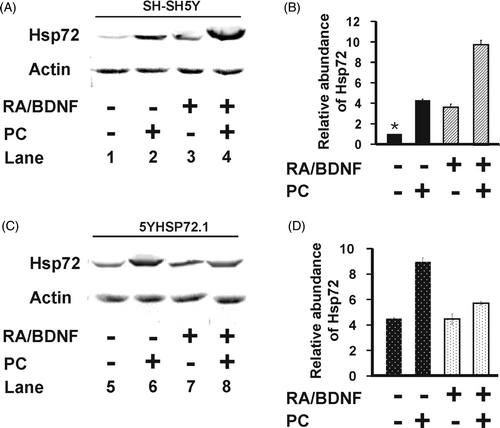
Figure 3. Hyperthermic resistance of undifferentiated but not neurone-like 5YHSP72.1 cells. (A) Cells were exposed to the indicated temperatures for 30 min and after 18 h recovery at 37°C, the percentage of cells undergoing cell death was determined. Results from untransformed SH-SY5Y cells are included for comparison. (B) Cells were thermally preconditioned (PC) at 43°C for 20 min and allowed to recover for 8 h at 37°C before subsequent heating at the temperatures shown. Results for non-preconditioned 5YHSP72.1 are included for comparison. All results are from three independent experiments. Error bars indicate standard deviation.
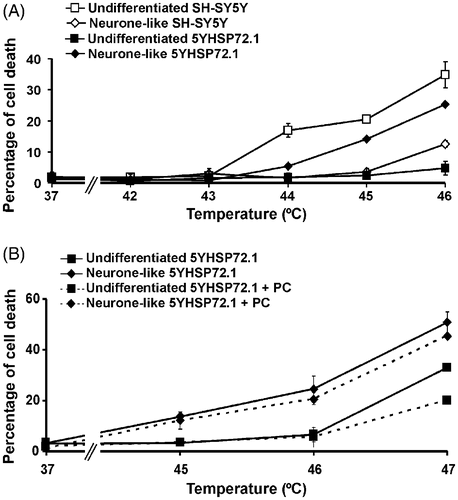
Figure 4. Correlation of Hsp72 expression levels and thermotolerance in both undifferentiated and neurone-like 5YHSP72.1 cells. (A) Undifferentiated and neurone-like 5YHSP72.1 cells were heated at the temperatures (°C) indicated for 30 min and allowed to recover for 8 h at 37°C before harvesting. Control cells (denoted C) were maintained at 37°C throughout. Lysates were subjected to western immunoblotting with anti-Hsp72 and actin antibodies. In this case secondary antibodies conjugated to horseradish peroxidise were used. (B) Levels of Hsp72 induction were quantified by densitometric analysis of the image in . *Fold induction values were normalised to the levels of Hsp72 in undifferentiated SH-SY5Y cells (denoted N) (see Supplementary ). Note that the values for fold induction are relatively smaller here than those shown for corresponding cells in because of systematic differences in the quantification of bands using ECL techniques as opposed to fluorometric techniques. (C) Cells were exposed to the indicated temperatures for 30 min and after 18 h recovery at 37°C, the percentage of cells undergoing cell death was determined. Where indicated, cells were thermally preconditioned (PC) at 43°C (PC43), 44°C (PC44) or 45°C (PC45) for 30 min before subsequent heating at the temperatures shown. All results are from three independent experiments. Error bars indicate standard deviation.
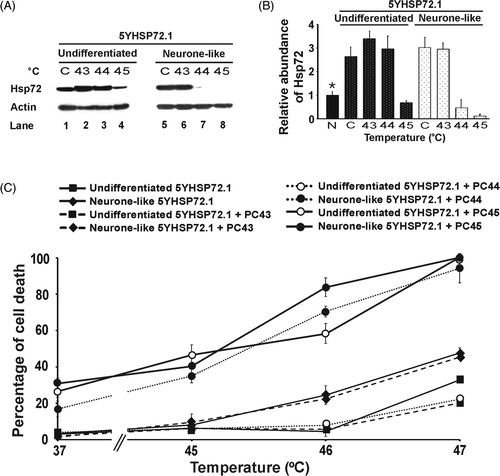
Figure 5. Inhibition of heat-induced expression of Hsp72 by KNK437. Cells were treated with various concentrations of KNK437 1 h before heating at 43°C for 30 min followed by 8 h recovery at 37°C (thermal preconditioning, PC) before harvesting. Control cells (denoted C) were maintained at 37°C throughout. Lysates were subjected to western analysis with anti-Hsp72 and actin antibodies. Levels of induction of Hsp72 were quantified by densitometric analysis of images. (A) Undifferentiated SH-SY5Y cells. (B) Neurone-like SH-SY5Y cells. In both cases, fold induction was normalised to the level of Hsp72 in the respective control. Note that for all concentrations of KNK437 applied, the input of DMSO was held constant; vehicle DMSO alone at 0.1% as used here had no measurable effect on Hsp72 levels. All results are from three independent experiments. Error bars indicate standard deviation.
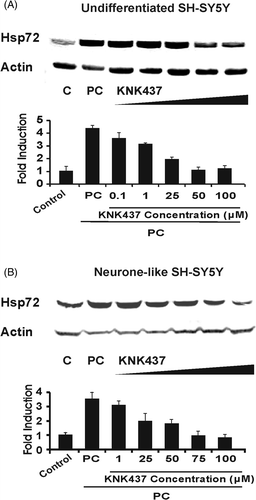
Figure 6. KNK437 sensitises SH-SY5Y and 5YHSP72.1 cells to thermal stress. Cells (either undifferentiated or neurone-like) were treated with or without KNK437 1 h before being heated at different temperatures for 30 min. Concentrations of KNK437 were 50 µM and 75 µM for undifferentiated and neurone-like cells, respectively. After the hyperthermic stress, cells were allowed to recover at 37°C for 18 h before harvesting and the percentage of cells displaying apoptotic nuclei was determined. Where indicated (PC), cells were treated with or without KNK437 1 h before being thermally preconditioned at 43°C for 30 min. After such thermal preconditioning (PC), cells were allowed to recover at 37°C for 8 h and then a secondary insult of a severe heat stress at the indicated temperature was carried out for 30 min. After the secondary heat stress, cells were allowed to recover at 37°C for 18 h before harvesting. (A) SH-SY5Y cells with and without KNK437. (B) 5YHSP72.1 cells with and without KNK437. (C) Thermally preconditioned SH-SY5Y cells with and without KNK437. (D) Thermally preconditioned 5YHSP72.1 cells with and without KNK437. Control cells treated with equivalent concentrations of KNK437 (without heat) or the vehicle DMSO alone, did not show measurable changes in cell viability relative to controls. All results are from three independent experiments. Error bars indicate standard deviation. Note the different temperature range adopted for the studies reported in each of the two rows.
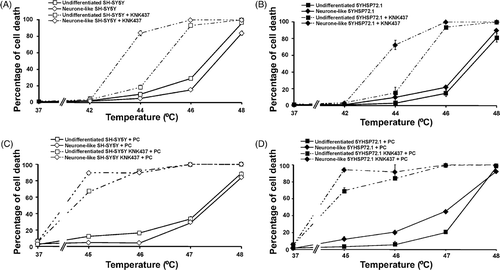
Supplementary Figure S1. Correlation of Hsp72 expression levels and thermotolerance of SH-SY5Y cells upon various pretreatment conditions. (A) Undifferentiated and neurone-like SH-SY5Y cells were heated at the temperatures (°C) indicated for 30 min and allowed to recover for 8 h at 37°C before harvesting. Control cells (denoted C) were maintained at 37°C throughout. Lysates were subjected to western immunoblotting with anti-Hsp72 and actin antibodies. In this case secondary antibodies conjugated to horseradish peroxidise were used. (B) Levels of Hsp72 induction were quantified by densitometric analysis of the image in . *Fold induction values were normalised to the levels of Hsp72 in undifferentiated SH-SY5Y cells (denoted N); this reference value was likewise used for normalisation of data in (N). Note that the values for fold induction are relatively smaller here than those shown for corresponding cells in because of systematic differences in the quantification of bands using ECL techniques as opposed to fluorometric techniques. (C) Cells were exposed to the indicated temperatures for 30 min and after 18 h recovery at 37°C, the percentage of cells undergoing cell death was determined. Where indicated, cells were thermally preconditioned (PC) at 43°C (PC43), 44°C (PC44) or 45°C (PC45) for 30 min before subsequent heating at the temperatures shown. All results are from three independent experiments. Error bars indicate standard deviation.
